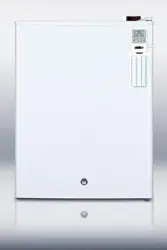Loading ...
Loading ...
Loading ...

Page 13
a. Store vaccine in storage units designated specifically for biologics. If biologic specimens
must be stored in the same unit, these should be stored on a lower shelf to prevent
contamination. Food and drinks should never be stored in the same unit with vaccines.
b. Read and document refrigerator and freezer temperatures at least twice each workday- in
the morning and before the end of the workday. Keep temperature logs for at least 3
years.
c. Good air circulation around the vaccine storage unit is essential for proper heat exchange
and cooling functions. The unit should be in a well-ventilated room with space around the
sides and top and at least 4” between the unit and a wall or 2” if capable of built-in
installation. Nothing should block the cover of the motor compartment and the unit should
be level and stand firmly with at least 1 to 2” between the bottom of the unit and the floor.
d. Store vaccines on the shelves away from the walls and vents in the part of the unit best
able to maintain the required temperature.
e. Store unopened and opened vaccines in their original box with the lid in place until
administration. This practice also helps to ensure different vaccines are not stored
together in the same bins or containers which can lead to vaccine administration errors.
And in the event of a power failure, studies have shown storing vaccines in the box helps
to maintain the vaccine at the appropriate temperature.
Temperature Monitoring Devices
Thermometers with alarm function
Thermometers are a critical part of good storage and handling practice. The freezer and the
refrigerator unit or compartment should each have its own thermometer. For measuring vaccine
storage unit temperatures, CDC recommends using only calibrated thermometers with a
Certificate of Traceability and Calibration.
CDC recommends thermometers with the following characteristics:
Provide continuous monitoring information with an active display.
Be a digital thermometer with a probe in a glycol-filled bottle.
Include an alarm for out-of-range temperatures.
Have a reset button if using a thermometer with a min/max display.
Be capable of showing current temperature as well as minimum and maximum
temperatures.
Have a low battery indicator.
Temperature Sensors
CDC recommends thermometers that employ temperature probes. Probes are available in two forms: a
standard probe that will measure air temperature and a bio-safe glycol-encased probe (i.e., probe
suspended in glycol) that will measure liquid temperature. Glycol-encased probes can provide a more
accurate reading of actual vaccine temperature and are therefore recommended by CDC.
Data Loggers
CDC recommends using digital data loggers for continuous temperature monitoring in vaccine
storage units. These miniature electronic devices may be programmed to record temperatures
at intervals throughout the day, with the frequency of reading set by the user. Digital data logger
Loading ...
Loading ...
Loading ...
